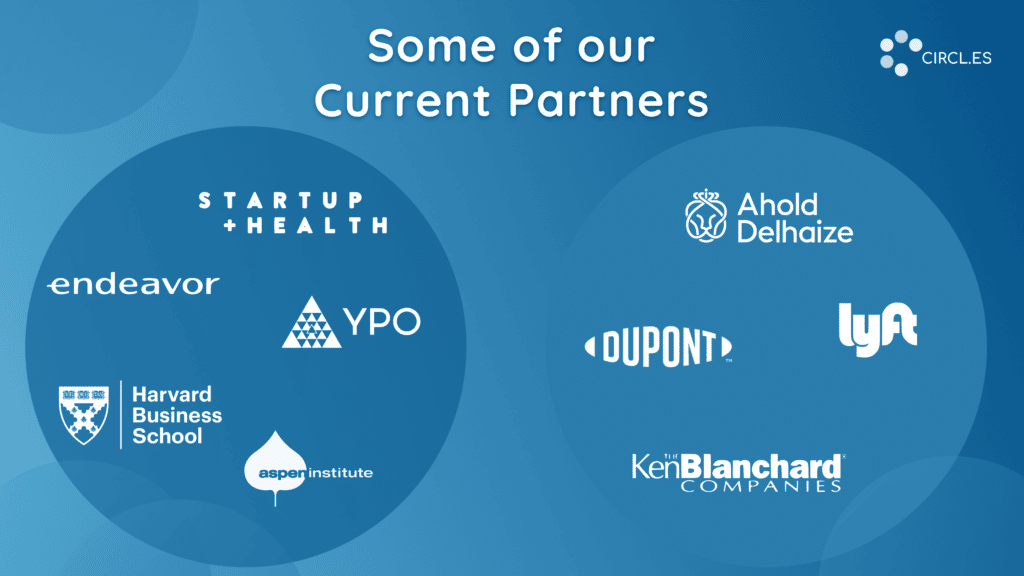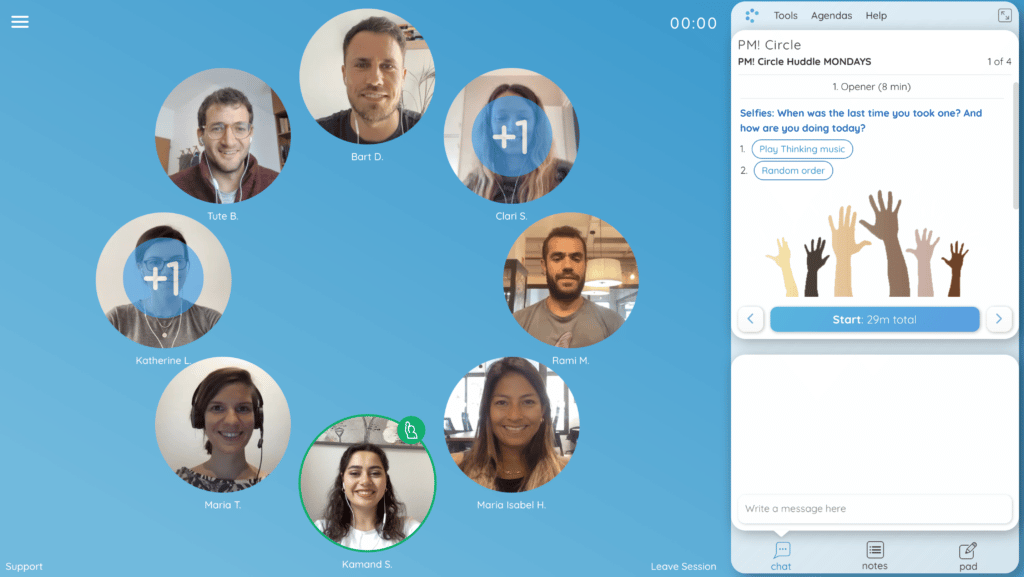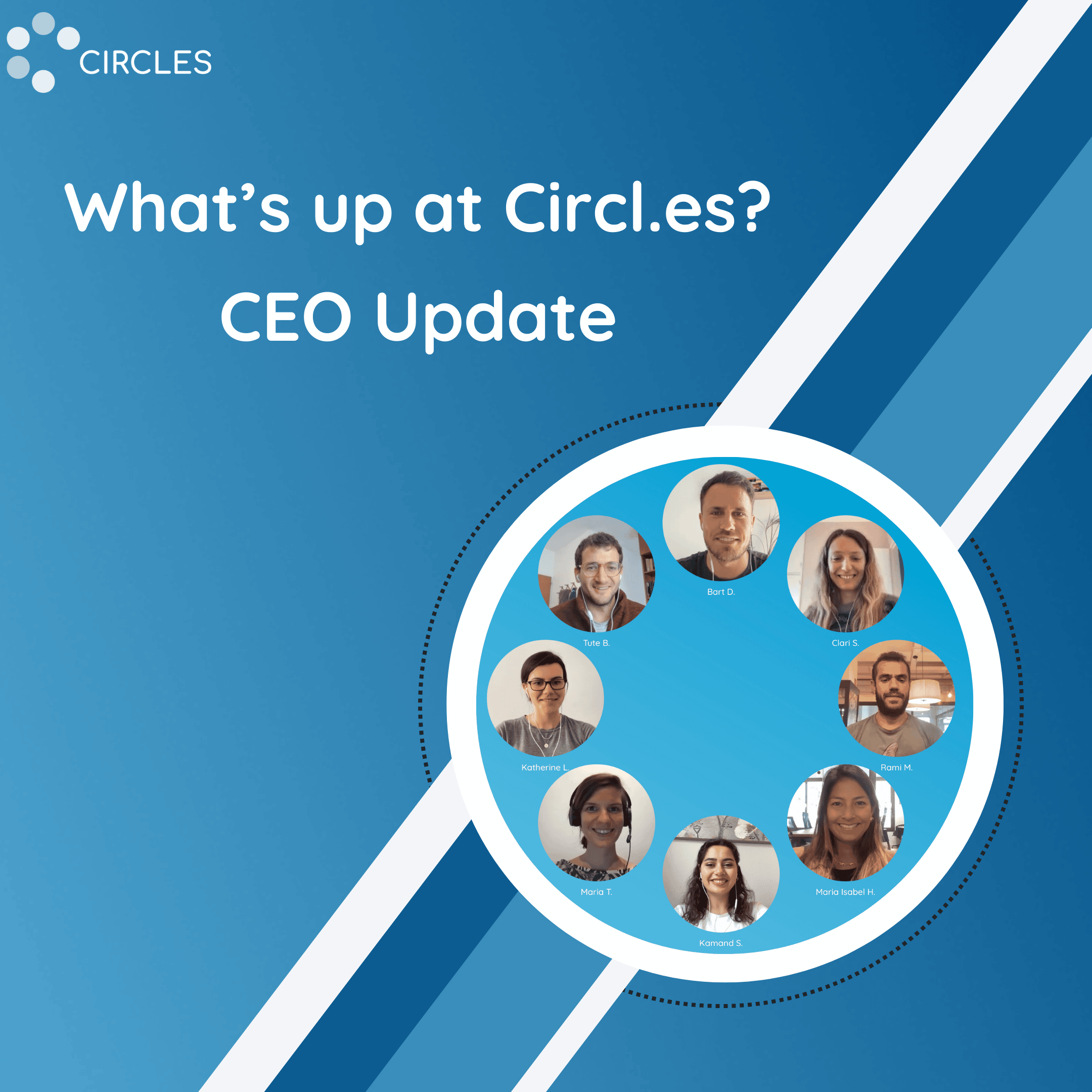Over the years, we’ve delivered authentic human connection for circles of school kids, grown-ups, faith-based communities, micro-entrepreneurs, climate activists, universities, medical teams and more. We’ve built a system and technology to support them, with many applications.
Now, we’re focused on simplifying our business model in order to create a sustainable company that can fulfill our mission: providing inclusive spaces where people can connect and grow.
On Building Direct-to-Company Sales
The earliest Circl.es adopters weren’t specific companies, they were communities that spanned several organizations, such as Harvard Business School, Aspen, Young Presidents Organization and Ken Blanchard Companies. As of this writing, communities (vs. organizations) still account for over half of our revenue.

With or without a campus, we believe community is the future of learning. A recent quote I’ve been pondering suggests that “Building community is to the collective as spiritual practice is to the individual’ (Grace Lee Boggs).
Yet while we love partners that span multiple companies, it was hard to build a fast-growth company without many individual companies or organizations as primary partners.
In 2021, we had a few crushing disappointments as we waited for partners to step on the gas.
In 2022, we sensed that these communities would be even slower in the face of an economic slowdown.
In the meantime, I made some expensive marketing decisions that didn’t pan out. We spun our wheels for a year as a result. I want to celebrate my partner Bart de Vocht who was running operations and then stepped into marketing, saying “I can solve this.” His excellent team, led by Maria Tenberge and Luz García Garona rose to replace him, and Bart created a B2B lead-gen machine. How? By zeroing in on our target prospects within companies, and inviting them into circles with each other.
The answer was under our nose, and it’s a “who” not a what. There’s a new type of leader rising in the business world, who wants to listen to and connect with one another. They believe in relationships over transactions, conversations over presentations. They’re struggling to fight disconnection at work and achieve a sense of belonging together.
And–backed by data from this funnel–we continue narrowing our focus.
We recently simplified our offerings to a menu of concrete, popular programs that add social learning to Diversity, Equity & Inclusion, Leadership Development, Onboarding and several other applications that our clients have helped us invent over the years.
On Sucking it Up and Rearchitecting our Video Space
We have a cadence of quarterly business reviews, which we weirdly call “offsites” out of longing for our in-person days. In the April ‘22 offsite, we discussed how to develop technology features faster. This is always a sensitive discussion, and finally our development team, led by the sage Bernard Duggan, got fired up. “You want speed? Pay down the Tech Debt!” (Do I need to define?)
His concern was valid: often, just when you get the features right, the business takes off, and it’s really hard to hit the pause button, take months off from adding new features, and tear it all down. Additionally, some companies build lots of features quickly, producing a tangled spaghetti code.
When Franko and I started Circl.es, we had many late night discussions about M5 Networks where we both worked, and what we were going to do differently at Circl.es. One thing we agreed on was a move that’s hard to pull off: quickly build a prototype to test ideas, then once we’re clear, tear it down and rebuild the right way. Founding teams struggle with this all the time. Mitch Kapoor of Lotus Notes famously stopped the whole train in the midst of a huge success, to completely rewrite. It was the difference between good and great: Notes went on to become dominant for a decade.
“The customer doesn’t come first” is a cliche sometimes attributed to Southwest Airlines founder Herb Kelleher, and we’ve found it to be true: if you listen to your employees first, they will take care of the customers. So we did–we listened to Bernard and gave our development team 6-9 months to rebuild the video room, our biggest source of tech debt–and our customers in turn experience a much better product. The foundations of this rewrite went live on our alpha environment this week.
On Sustainable Profitability
Last year, having passed most of the typical Series A financial milestones, we started meeting with VCs. I DO want to build a big company fast and have a big impact sooner than later. I had a good experience with the VCs that helped me build M5 and I know a lot of great people in this profession. But, having been through the VC-backed journey, I had reservations. And to be honest, no one was jumping over the table to fund us. My excuses were: I was more interested in running the business, unwilling to play the exaggeration game, maybe much more interested in talking about mission than making better slides. Eventually, I stopped pushing on the VC front, because customers started pulling.
Turning the corner into 2023, we are a beat away from sustainability: able to support growth and a software development team on our own. We’ve had the incredible support and patience of our seed investors. I don’t think my heart is saying no forever; if in the future, the opportunity is clear, the investor is right, and the team is ready we’ll absolutely entertain outside financing. But I have to say, I’m thrilled with how this shook out.
On Circles@circles
My last circles@circles session was weird and wonderful. What’s circles@circles? It is us drinking our own champagne. We’ve run several “Seasons” of circles programs for our 25-person company: our “community of belonging” program, a custom DEIB journey, Onboarding, A She/Her Circle, and now a more open-ended peer connection design. We’re a time-zone mess, so this ain’t easy. The experience not only connects us fabulously, it reliably delivers insights about what our clients experience.

Back to weird and wonderful: in our circles, we talk about weight loss, burnout, struggles prioritizing, wasted workdays, fear of losing a parent. I noticed some stressy voices in my own head: should we be spending an hour on this at work? Is it ok to be the CEO in this room, or am I in the way?
And then I realized that these circles are gold. They’ve impacted my connection to my colleagues, who are now influencing me more than ever, and improving my understanding of our company.
This aligns with Microsoft’s recent huge study of hybrid work which led them to stop measuring engagement and start measuring flourishing. Wellness became the measure of how their workforce is doing. It isn’t just about the work. I heard somewhere that your company grows as fast as your people do, and I agree. But the last couple of years have revealed a whole other level to the game. Your company is only as well as your people. And this is EXACTLY what giving space for community at work can help with.
Well, thanks for reading this far into storytime. I’d be curious to hear if you all think this is the right kind of company update.
Our work fighting disconnection has become more urgent as the world sees deepening polarization, a disengaged workforce, kids left years behind, and declining mental health. Many blame technology: social media, distributed work tools, online classrooms. But we’re techno-optimists. Our diagnosis is that it isn’t technology itself, it is the way it is built and structured. Facebook, Zoom and Netflix make it easy to amass huge groups, lined up in rows, facing experts or entertainers, connecting us in a shallow way (or just broadcasting at each other). The Circles System produces a deeper, more authentic human connection, consistently.
There’s a time for rows, and certainly a time to be alone too, but it is out of balance.
What people need more of are circles.
